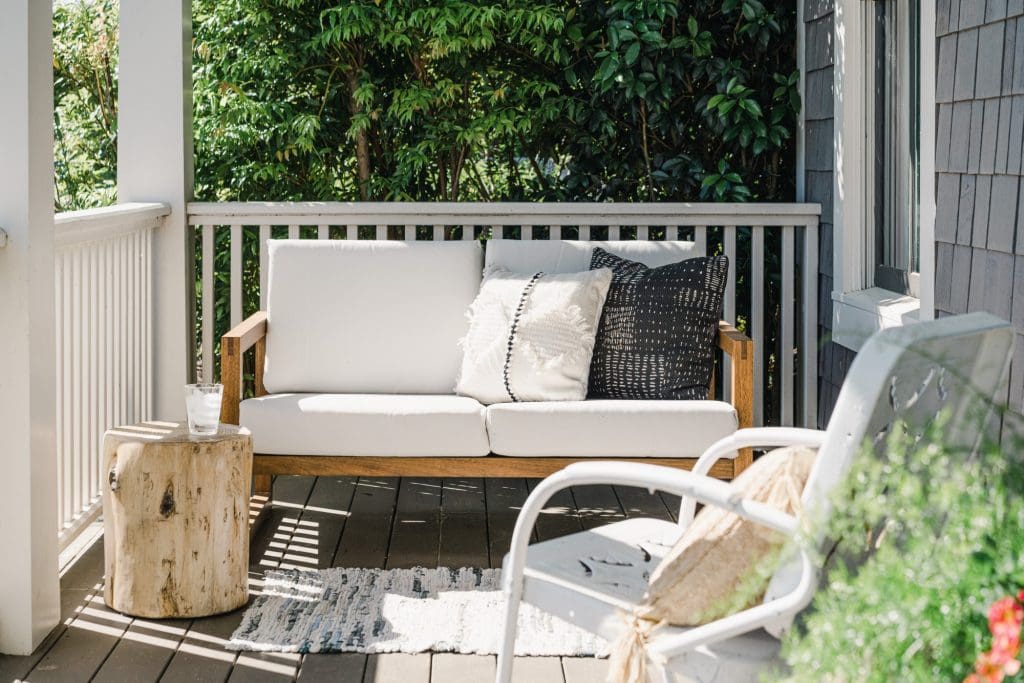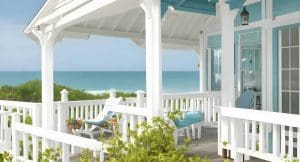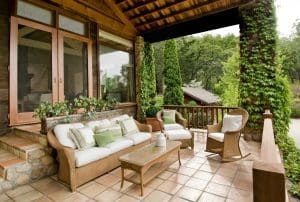
7 Tips for Adding a Porch Addition to Your Home
What’s better than sipping your morning coffee while watching the warm summer sunrise? Sipping that coffee on your front porch. Here are 7 tips for adding a porch addition to your home.
A porch is often one of a home’s most-loved features. They offer a seamless blend of indoor comfort and outdoor charm. They’re the perfect setup for inviting friends over for cards and margaritas, watching your kids play, and taking a short break from work to just sit down and relax.
However, while most of us love the idea of a porch, they’re not easy to build. It needs to be functional and aesthetically pleasing. You also need to be mindful of its size, what type of porch you want, how you’ll use it, and much more.
To help you get started, here are a few tips and tricks for adding a porch addition to a house:
1. Carefully Read Your Neighborhood Regulations
 Before you break out the tape measurer, sift through your homeowner’s association (HOA) guidelines and local zoning regulations to determine if you can build a porch addition. Some associations won’t allow it even though it’s on your own property.
Before you break out the tape measurer, sift through your homeowner’s association (HOA) guidelines and local zoning regulations to determine if you can build a porch addition. Some associations won’t allow it even though it’s on your own property.
Check your local government or county website to determine whether you need a permit, or visit MyBuildingPermit.com. Between these sites and your HOA guidelines, you should get the answer you need.
2. What Type of Porch Do You Want?
The official definition of a porch is “an exterior appendage to a building, forming a covered approach or vestibule to a doorway.” They’re also almost always elevated and require a ramp or stairs to access from the outside. These are usually the only differentiators between a porch and a patio or deck.
It’s also a pretty broad definition, meaning that porches can come in all shapes and sizes. Here are a few of the most common types of porch additions and their characteristics:

Front and Back Porches
You guessed it — these porches are located at the front or back of your house. They tend to be square or rectangular additions that protrude from a section of your home. Typically, back porches are larger because there’s usually more space, while front porches are smaller but more aesthetically appealing due to their visibility.
Wraparound Porches
 These porches wrap around the side of your home — sometimes all the way around, providing you with a ton of extra space. Wraparound porches are more common in more rural areas or larger plots of land. Due to their size, they also tend to be more expensive.
These porches wrap around the side of your home — sometimes all the way around, providing you with a ton of extra space. Wraparound porches are more common in more rural areas or larger plots of land. Due to their size, they also tend to be more expensive.
Open Porches
Open porches are devoid of walls, windows, or screens. While covered, they welcome the open air from all sides, excluding where your front or back door resides. When you think about porches, open porches are usually what comes to mind.
Enclosed Porches
Enclosed porches are additions that are either screened or walled off. They provide the feeling of being outdoors without having to worry as much about bugs, pests, and rainfall.
3. Create a Porch Addition Checklist

Next, it’s time to think about function. In other words, how will you use the space? If you’re unsure, here are a few questions to ponder:
- Why do you want to add a porch to your home?
- Do you want something just large enough for you, your spouse, and a pair of rocking chairs, or are you looking to entertain?
- Do you want your porch to be open, enclosed, or screened?
- How much seating will you need?
- What type of lighting do you want?
- What type(s) of furniture are you looking to include?
- Will your porch require heating or a ceiling fan?
- Will you be using any electronics (TV, sound systems, projector, etc.)?
- Do you want to add a bar or bar cart?
Next, list every feature you’d like to include and rank them from most to least important. This will help you prioritize what you want and need, which will come in handy when you’re getting quotes and organizing your budget.
4. How Much Seating Will You Need?
 If you want to dine outside, you’ll need enough room for a table, chairs, and a walkway. If you’re looking to host dinner parties, your porch is going to require a lot of depth. Typically, your porch should be at least 8 X 10 feet. deep if you want a decent-sized table and chairs, but Archadeck suggests that the average porch size is closer to 14 X 16 feet.
If you want to dine outside, you’ll need enough room for a table, chairs, and a walkway. If you’re looking to host dinner parties, your porch is going to require a lot of depth. Typically, your porch should be at least 8 X 10 feet. deep if you want a decent-sized table and chairs, but Archadeck suggests that the average porch size is closer to 14 X 16 feet.
Again, it all depends on how you’re using your space.
5. What Materials Should You Use?
The materials you use impact your porch addition’s aesthetic and upkeep. Common porch material include:
-
- Composite boards are usually the easiest to maintain. Composite boards comprise of a blend of wood fibers and plaster and are typically encased in a thin, protective layer of plastic to resist fading or staining. While they’re one of the most expensive porch materials, they often come with 20- to 25-year-long warranties.
- Lumber can be a good option, but make sure you’re selecting a type of lumber that works well in your area. Redwood can do well in Washington State because it can withstand moisture, but Douglas Fir may shrink or warp when exposed to our fluctuating weather conditions. Lumber is also more maintenance, depending on which type you choose.
- Pressure-treated lumber is treated with preservatives, making it more resistant to rot, decay, and infestations. However, the chemicals used in pressure-treated lumber can harm the environment.
Concrete, or concrete with an overlay of stone or tile, is another great option.
6. Porch Addition Ideas for Lighting
From pendant lights to wall sconces, your porch has plenty of lighting options.
- Recessed Lighting: Recessed lighting is as sleek as it is unobtrusive. By installing recessed lights into your porch’s overhead, you’ll forget they’re there — and so will your guests. Go the extra mile by installing dimmable LED bulbs to adjust the ambiance whenever you’d like!
- Lanterns: You can hang battery-powered LED lanterns and enjoy their calming, cozy glow, or place one on your table and enjoy an intimate dinner for two.

- String Lights: There’s something whimsical about string lighting. You can wrap them around your pillars and rails or create a canopy effect by crisscrossing them overhead. String lights are a perfect addition for the holiday season, but with color-changing bulbs, you can find a use for them all year round.
- Solar-Powered Lights: Solar-powered lights absorb sunlight during the day and illuminate your porch at night. You can spring for solar path lights along your porch perimeter or use solar-powered lanterns or string lights to save on energy costs.
- Motion Sensors: Motion sensor lighting automatically turns on and off, providing added security while saving you money. They’ll turn on when you approach and can also deter unwanted visitors.
7. Hire Pathway For Your Porch Addition
Whether you’re looking to add a porch addition to a house or want a porch addition remodel, Pathway is here to help! We’re BIAW-certified home builders that specialize in leveraging smart design and eco-friendly, wellness-conscious practices all throughout the building process.
Are you ready to enjoy a healthier, greener, and more functional living space that adds value and longevity to your home? Send us a message today!
Do you like home remodeling tips?
Remodeling your home can be a daunting experience. The Pathway team has taken the time and expertise to create podcast episodes detailing the tips and tricks of the trade.
